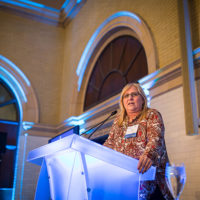In lieu of Minneapolis hosting Super Bowl LII in February and considering the influx of human trafficking brought by a large sporting event, on January 11, the ACAMS Greater Twin Cities Chapter (GTCC) hosted a learning event to spread human trafficking awareness. The learning event fell on not only National Slavery and Human Trafficking Prevention Month and Human Trafficking Awareness Day, but also on the Blue Campaign’s day to pledge solidarity with victims and to raise awareness.
The chapter board met frequently to plan the event and to determine the venue, communications, finances, registration, photos, topics and speakers. As the planning progressed, it was determined that a half-day event would be appropriate in order to include key topics, which would provide the awareness needed in the industry. The event was split into four sessions, which included:
- Understanding the motivations and makings of a trafficker;
- Guidance for institutions to consider to identify possible human trafficking and to partner with law enforcement;
- Understanding the impact of human trafficking on the survivor and the support of advocacy services; and
- A survivor’s testimony.
The passion and dedication to further address and bring attention to this crime brought very willing, knowledgeable and respected speakers to the chapter event. In addition, thanks to the support of Thomson Reuters, the event sponsor, the event included lunch, a dessert break and a networking opportunity.
On the day of the event, Co-Chair Shannon Bennett, senior vice president of financial crime portfolio PMO at U.S. Bank, kicked off the event to an audience of over 250 and highlighted the importance of the day and month of the event. She talked about the 40 million victims of human trafficking throughout the world. She also recognized the non-partisan focus placed on human trafficking by both the former and current administrations in the efforts to dismantle criminal organizations that perpetuate the heinous crime of human trafficking.
Bennett then recognized the members of the board for their efforts, along with Phil DeLuca, senior vice president of enterprise crimes compliance control at U.S. Bank (named honorary board member), for all his support and assistance. Thomson Reuters was then thanked for their sponsorship, as Amanda DuPont of Thomson Reuters joined Bennett on stage. Dupont spoke to the attendees about what an honor it was for them to support the event.
As a chapter, the GTCC has been very fortunate to have the frequent support of Dennis Lormel, president and CEO of DML Associates and former chief of the FBI’s Financial Crimes Program. Lormel served 28 years as a special agent and in 2000 was promoted to chief of the FBI’s Financial Crimes Program. His dedication to provide education through his experience to the Minneapolis financial industry and law enforcement community has been instrumental in the success of several of the chapter’s larger events. Lormel opened the first session, “Deconstructing the Trafficker,” which focused on understanding the risk, mindset and attributes of a trafficker. He started with a heartfelt discussion and an image of a young family member and another of a victim similar in age to provide the audience with a relatable understanding of how this crime can impact any age, group or family. Throughout his discussion, his message was on how “awareness leads to prevention.”
Lormel spoke about some of the recent cases that have been in the media and the ages of those victims (as young as three months and five years old) that were recovered due to some of the focused efforts of law enforcement.
Lormel shared details of his first encounter in the late 70s with a trafficker and his victim (15 to 16 years old) at a fast food restaurant. It was apparent that the incident still affects him today and to the audience it was clear how even back then when little was known beyond thinking it was prostitution, that he was doing the right thing and protecting the victim. Lormel’s message of how this crime has gained a greater level of understanding over the past decade has helped law enforcement in identifying and prosecuting human trafficking. He emphasized that sentencing needs to be a strong deterrent.
In addition, Lormel provided the audience with a list of human-trafficking warning signs. He spoke about the warning signs he saw from the trafficker at that fast food restaurant, which still apply today. In addition, Lormel provided an understanding of the makings of a trafficker, their motivation and attributes, who they target, how victims are transported and where traffickers are vulnerable when financing their crime via the banking system. He recommended Typologies of Modern Slavery as a tool for further understanding and education.1 He explained that the report includes 15 years of data put together by Polaris, a nonprofit organization (NPO) thatworks globally to put an end to modern slavery. He also shared the collaboration of Polaris and ACAMS to provide education and awareness of human trafficking.
He closed his session by reminding the audience how awareness leads to prevention and the importance of partnerships, perspective and innovation.
Partnering to Identify and Report Human Trafficking from the Transaction
The next session, “Partnering to Identify and Report Human Trafficking from the Transaction,” provided guidance and awareness on the current initiative that law enforcement and U.S. Bank, along with other financial institutions, are driving to identify and report possible human trafficking.
The session was moderated by Jim Dinkins, senior vice president and director of operations at U.S. Bank in enterprise financial crimes compliance. Dinkins served in federal law enforcement in a number of key senior leadership roles within the U.S. Department of Homeland Security.
The panel, all active in the current initiative, included:
- Anna Cunningham, vice president of enterprise financial crimes compliance at U.S. Bank, whose primary role is to coordinate with federal law enforcement on emerging threats in money laundering and terrorist financing
- Karen Schommer, deputy criminal chief of major crimes and priority prosecutions for the District of Minnesota, whose role is to handle cases, including violent crimes, bank robberies, fraud, immigration-related offenses, child exploitation and human trafficking, among others
- Christopher Oelkers, special agent for Homeland Security Investigations for 22 years, serving in Kansas City, Missouri and Minnesota. Special Agent Oelkers currently supervises investigations involving human smuggling and human trafficking
The session began with Dinkins sharing his unique perspectives due to his work in both law enforcement and now the financial industry. Dinkins shared a video to show how over the last 10 years there has been more awareness on human trafficking. The statistics of victims of human trafficking were shocking: 1.5 million victims are in the U.S. and the average age of human trafficking victims is 12 to 14 years old. Dinkins explained that this is a society issue, not just a law enforcement issue.
Oelkers then provided clarity on the differences between human trafficking and human smuggling. He explained that human trafficking is involuntary and the decision is made on behalf of the individual by the trafficker and that human smuggling is a voluntary decision made by the individual(s). Oelkers also spoke about the exploitation of minors and the need to understand what draws minors into the control of the traffickers. He expanded on the big issue of whom the minors place their trust in and how they do not trust law enforcement.
Oelkers was asked to speak about the financial component of the transactions and Schommer joined the discussion. They spoke about the use of microstructuring from different branches, the use of online adult service advertising, some of the activity a financial institution would see, such as hotels, the number of times transactions occur at an ATM and the money being funneled in from all over the country.
Oelkers and Schommer spoke about the more defined information law enforcement is getting in the suspicious activity reports (SARs) due to awareness. Schommer placed emphasis on the narrative that should describe the story. She asked the audience to focus on telling the story by describing what it is that the investigator is seeing in the activity in the narrative.
Dinkins then turned over the discussion to Cunningham and asked her to provide some insight into the anti-human trafficking initiative that she was involved in spearheading. Cunningham began by speaking about how 71 percent of children are exploited via online adult service advertising, despite the termination of adult services postings in January 2017. She discussed her bank’s focus to develop a human trafficking typology to identify accounts with certain types of activities that have attributes potentially indicative of human trafficking compared to normal activity.
Cunningham then spoke about the upcoming Super Bowl and what U.S. Bank is doing prior to the event. In addition, she spoke about their peer-bank working group and their partnership with a third-party vendor to identify potential criminal rings and victims to help law enforcement combat human trafficking.
The session ended with numerous questions from the audience to both law enforcement and U.S. Bank.
Working with Survivors of Human Trafficking
The second half of the event was focused on providing the audience with a better understanding of the impact human trafficking has on survivors. The event reconvened after a short dessert break where Co-Chair Sande Bayer, vice president of wealth management and investment services CRO AML at U.S. Bank, provided a warm introduction and shared her passion for the subject.
Bayer then introduced the next topic “Working with Survivors of Human Trafficking” and the speaker Maggie Falwell, community liaison and advocate for Cornerstone Advocacy Services. Falwell has worked with survivors of all ages at Cornerstone for over five years. Cornerstone’s mission is to rebuild lives and restore hope. Falwell’s experience and confidence in speaking to groups on this sensitive and emotionally intense subject was immediately apparent.
Falwell opened the session by reading a poem from a survivor that shared their attempt at suicide. The poem had the audience teary-eyed over the trauma the victims of human trafficking suffer.
Throughout Falwell’s presentation, she brought both a light touch of humor and a clear understanding of a very difficult topic. She spoke about the laws in Minnesota and the distinction between human trafficking and prostitution. Falwell also shared the No Wrong Door System initiative. The No Wrong Door System initiative is a multidisciplinary and multijurisdictional approach that no matter where a youth is identified, every professional will be able to identify exploitation and know where to refer the youth for appropriate services.
Falwell then asked the audience if anyone understood the basic economic principal behind sex trafficking. When no one responded, she jokingly said, “A room full of bankers and no one recognizes the basic principal of supply and demand?” The room broke out in chuckles, and she had everyone’s attention and a sense of levity was established on this emotionally charged subject. A discussion on the factors influencing demand ensued. These factors include the easy accessibility of pornography, the acceptance of violence on individuals in the sex industry, the dehumanization of women in the sex industry, our society’s sexual objectification of women and girls, and the perception that there are little consequences to these violations.
During Falwell’s presentation, there was a picture of a female laying on her stomach with her head turned to the camera against a leopard print wall. She had spiked heels, her clothing had cutouts, her hair was pulled up and her makeup perfectly emphasized her features. Falwell asked the audience to guess the girl’s age. The audience guessed ages from 14 to 20. The room was speechless when she shared the girl was 8 years old.
Falwell explained what the trafficker does and who they are in relation to the victims, how they recruit and groom the victims and the means they take to keep them under control. She then went on to explain the risk factors of those individuals that may become victims. She also shared basic tips on interacting with possible victims.
Throughout her presentation, Falwell shared stories that brought the message very close to home. She spoke of her interaction with today’s youth and the influence of the songs they hear and the images that they see every day (with the example she shared earlier) that is shaping them and their ideals. She also spoke about the demand in the state of Minnesota and when/where the activity typically occurs.
Bayer then introduced Terry Forliti, executive director of Breaking Free, who is also a survivor and the final speaker. Bayer referenced Forliti’s speaker biography that was handed out to the attendees, and shared that on several occasions they worked together in sponsoring and supporting the same anti-human trafficking events.
Forliti started the session with these words, “The act of prostitution is the most heinous, invasive abuse that a person can endure. It is wrong on so many levels and needs to be exposed for what it is—the world’s oldest oppression. It angers me when the media glorifies prostitution. There is absolutely nothing glamorous about it.”
She then continued by sharing the efforts of the Minnesota Human Trafficking Task Force and the Super Bowl Host Committee that have been ongoing over the last two years. This effort includes research by the Women’s Foundation of Minnesota, local law enforcement, airport security, as well as many hotels and hospitals to ensure and provide staff training to identify possible victims. These were all considerations included in the anti-human trafficking effort for the 10-day events planned prior to Super Bowl LII.
Forliti then shared her human trafficking survivor story. She spoke about her upbringing in a prestigious white-collar community in the Twin Cities where many of her neighbors were professional athletes. Both of her parents were highly successful in their professional careers, so she never had to want for anything.
She shared that a series of events, including being raped by her employer at age 15, her parents’ divorce and a serious accident involving one of her best friends, led her to find comfort in doing recreational drugs. Forliti witnessed that many of her esteemed neighbors were doing recreational drugs and had no negative consequences, so she found it to be accepted.
Forliti managed to maintain a normal life with a corporate job, as a wife and as a mother of two young children for several years while doing recreational drugs. However, she hit rock bottom when she discovered her husband with another woman, when her drug dealer was arrested and when she lost her job. She found comfort in drugs and this time there was a higher price to pay. She lost custody of her children and became homeless. Forliti still had no intention of prostituting herself, but her addiction made her vulnerable and she was soon manipulated by a group of drug dealers and pimps. She shared some graphic and intense memories of those years before she left the life.
At the end of Forliti’s presentation, one of the attendees came to the microphone to ask a question. Instead of asking a question, he said, “Thank you for sharing” and started clapping. The room joined in applause and gave her a standing ovation. Over 250 people stood up and recognized the pain and struggles she endured. It was transparent that only a strong and confident person could share such intimate details to a group of strangers. It was a very heartfelt moment for everyone in the room.
There were a few other learning moments during the event, one being that the financial industry’s interest and efforts in these crimes is not widely known within the social services sector. It cannot be assumed that everyone outside the industry understands the anti-money laundering requirements, reporting efforts or its acronyms. This was apparent during the first half of the session when Forliti leaned over and asked Bayer why the banks are filing so many SARs. Bayer explained the filing criteria to Forliti, who then explained a SAR in her world is a sexual assault report. This is a clear example of the confusion acronyms can bring to a discussion with those outside the industry.
Conclusion
In summary, the GTCC’s event was successful due to the efforts of the board members and the amazing speakers, the support of its generous sponsor Thomson Reuters and the participation of the chapter’s membership and community. The knowledge, insights and realities that were shared benefited and motivated everyone to continue fighting this horrific crime.
Although our event took place on National Human Trafficking Awareness Day and it focused on human trafficking around large sporting events, a message from all of our speakers is that this is a crime that takes place every day and no community is spared from its horrific impact. GTCC recognizes the ongoing support our community needs for education and survivor programs. Our chapter was proud to donate the registration fees it collected for this event and we were able to match that donation with chapter funds, which were equally divided between Cornerstone and Breaking Free to support their programs.
As a chapter, we would also like to give recognition to its photographers Adam Goldstein and Alisha Siemens of Shema Global. Shema is working to create 25 sewing co-ops in Southeast Asia to employ girls rescued from sex trafficking.
If after reading this article, you would like to support either of these organizations, please visit their websites below:
For information on how you can join a local chapter to discuss and learn about region-specific issues, please visit http://www.acams.org/acams-chapters/.






































